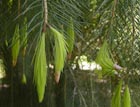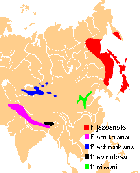Picea smithiana
(Wallich) Boissier 1884
Common names
Rai (Silba 1986), 长叶云杉 changye yunshan [Chinese].
Taxonomic notes
Syn: Pinus smithiana Wall.
Description
Trees to 60 m tall and 200 cm dbh, with a conical crown of pendulous branchlets. Bark pale brown, breaking into irregular plates. Branchlets pale brown or pale gray, glabrous. Leaves spreading radially, directed obliquely forward, slender, curved, quadrangular in cross section, 33-55×1.3-1.8 mm, with 2-5 stomatal lines on each surface, apex acute or acuminate. Seed cones green, maturing brown, lustrous, cylindric, 10-18 × 4.5-5 cm. Seed scales broadly obovate, thick, ca. 3 × 2.4 cm, broadly triangular-obtuse. Seeds dark brown, ca. 5 mm, with a 10-15 mm wing (Wu and Raven 1999).
Distribution and Ecology
Afghanistan, India: Kashmir, Nepal, Pakistan, S Tibet Wu and Raven (1999). Hardy to Zone 7 (cold hardiness limit between -17.7°C and -12.2°C) (Bannister and Neuner 2001).
Remarkable Specimens
Vladimir Dinets (e-mail, 2004.11.14) reports trees in Pakistan up to 50 m tall.
The oldest known living specimen, 612 years, was documented in a tree-ring chronology covering the period 1394-2005 (crossdated after 1410), collected near Chera Gilgit, Pakistan by Edward R. Cook, Jonathan G. Palmer, and Moinuddin Ahmed (doi.org/10.25921/sz6f-6k55). This site was used in a dendroclimatic temperature reconstruction (PAGES 2k Consortium 2013).
Ethnobotany
No data as of 2023.11.06.
Observations
Vladimir Dinets (e-mail, 2004.1.14) reports that Kalam, in Pakistan's Swat Valley, has a large forest of Cedrus deodara with some Picea smithiana and Pinus wallichiana. He also found it growing along the trail to Nanga Parbat Base Camp. "The trailhead is accessible from Gilgit by a hired jeep, or from Raikot Bridge on the Karakoram Highway by
hitchhiking (early morning only). Near the trailhead are some Pinus gerardiana, Juniperus semiglobosa and Cupressus torulosa, higher up - Pinus wallichiana and Picea smithiana (slim, but up to 50 m tall)." See Dinets (2004) for further detail.
Remarks
The epithet remembers James Edward Smith (1759-1828), founder of the Linnaean Society of London (Wallich 1832).
Citations
Boissier, E. 1884. Flora Orientalis 5:700, accessed 2020.11.28.
Dinets, Vladimir. 2004. Ramadan in Pakistan. http://dinets.travel.ru/eibex.htm, accessed 2004.11.28, now defunct.
PAGES 2k Consortium. 2013. Continental-scale temperature variability during the past two millennia. Nature Geoscience 6:339-346. doi: 10.1038/NGEO1797
Wallich, N. 1832. Plantae Asiaticae rariores, or, Descriptions and figures of a select number of unpublished East Indian plants. Available: Biodiversity Heritage Library, accessed 2020.11.28 (see also illustration no. 246).
See also
Elwes and Henry 1906-1913 at the Biodiversity Heritage Library. This series of volumes, privately printed, provides some of the most engaging descriptions of conifers ever published. Although they only treat species cultivated in the U.K. and Ireland, and the taxonomy is a bit dated, still these accounts are thorough, treating such topics as species description, range, varieties, exceptionally old or tall specimens, remarkable trees, and cultivation. Despite being over a century old, they are generally accurate, and are illustrated with some remarkable photographs and lithographs.





